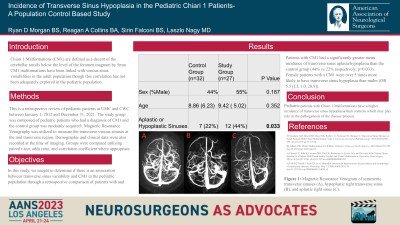Evaluation of Transverse Sinus Hpoplasia in Patients With Chiari 1 Malformation- A Population Control Based Study
Evaluation of Transverse Sinus Hpoplasia in Patients with Chiari 1 Malformation- a Population Control Based Study
Friday, April 21, 2023


Ryan D. Morgan
MS2
Texas Tech Univeristy Health Sciences Center
Lubbock, Texas, United States
ePoster Presenter(s)
Introduction: Chiari 1 Malformation (CM1) has been linked to dural venous sinus variabilities within the adult population; however, this correlation has not been adequately explored in the pediatric population. The purpose of this study is to analyze transverse sinus hypoplasia in patients with CM1.
Methods: This is a retrospective review of pediatric patients from January 1st 2012-December 31st 2021. Patients included had tonsillar ectopia of 5mm below the level of the foramen magnum or tonsillar ectopia with a previous or new diagnosis of CM1 based upon imaging and clinical presentation. The control group was acquired from a list of patients who presented for headache, dizziness, or traumatic brain. Patients and controls were excluded if they had a diagnosis of pseudotumor cerebri. Magnetic Resonance Venography was utilized to measure the transverse venous sinuses at the mid transverse region. Groups were compared utilizing paired t-test, odds ratio, and correlation coefficient where appropriate.
Results: The study and control population consisted of 27 and 32 patients respectively. There was no significant difference between groups in terms of gender (55% males vs 44%; p=0.187) or age (9.43 ± 5.02 vs 8.86 ± 6.23; p=0.352) for the study and control populations, respectively. Patients with CM1 had a significantly greater mean incidence of transverse sinus hypoplasia than the control group (44% vs 22% respectively, p=0.033). Female patients with a CM1 were over 5 times more likely to have transverse sinus hypoplasia than males (OR 5.5 [CI, 1.0, 28.9]; p=0.019); however, this trend was not significant in the control population (p= 0.188). Patients age was not associated with transverse sinus hypoplasia in the study or control population (correlation coefficient of 0.013 and 0.067 respectively).
Conclusion : Pediatric patients with Chiari 1 Malformations have a higher incidence of transverse sinus hypoplasia than controls which may play role in the pathogenesis of the disease process.
Methods: This is a retrospective review of pediatric patients from January 1st 2012-December 31st 2021. Patients included had tonsillar ectopia of 5mm below the level of the foramen magnum or tonsillar ectopia with a previous or new diagnosis of CM1 based upon imaging and clinical presentation. The control group was acquired from a list of patients who presented for headache, dizziness, or traumatic brain. Patients and controls were excluded if they had a diagnosis of pseudotumor cerebri. Magnetic Resonance Venography was utilized to measure the transverse venous sinuses at the mid transverse region. Groups were compared utilizing paired t-test, odds ratio, and correlation coefficient where appropriate.
Results: The study and control population consisted of 27 and 32 patients respectively. There was no significant difference between groups in terms of gender (55% males vs 44%; p=0.187) or age (9.43 ± 5.02 vs 8.86 ± 6.23; p=0.352) for the study and control populations, respectively. Patients with CM1 had a significantly greater mean incidence of transverse sinus hypoplasia than the control group (44% vs 22% respectively, p=0.033). Female patients with a CM1 were over 5 times more likely to have transverse sinus hypoplasia than males (OR 5.5 [CI, 1.0, 28.9]; p=0.019); however, this trend was not significant in the control population (p= 0.188). Patients age was not associated with transverse sinus hypoplasia in the study or control population (correlation coefficient of 0.013 and 0.067 respectively).
Conclusion : Pediatric patients with Chiari 1 Malformations have a higher incidence of transverse sinus hypoplasia than controls which may play role in the pathogenesis of the disease process.
